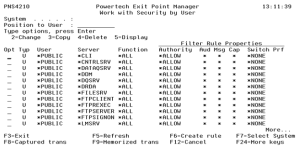How to Get There
From the Security Configuration Menu, choose option 2.
What it Does
The Work with Security by User panel allows you to maintain a user's server and server function rules. After entering a valid user profile, you can add, change, or delete the user's individual server and server function rules. You can also copy a user's rules to another user or delete all of the user's rules.
Options
2=Change
Choose this option for a rule to open the Change User Rule panel
3=Copy
Choose this option for a rule to open the Copy User Rule panel
4=Delete
Choose this option for a rule to delete it.
5=Display
Choose this option to display the User Rule Derivation panel
Field Descriptions
System
System indicates the target of any operations you perform. When you add rules, for example, those rules will be sent to, and will affect processing on, the System named. The following describes the fields on the Work with Security by Server panel.
Position to User
Used to position the list.
Opt
Enter a valid option from the list of options provided on the list panel.
Typ
This field is used to indicate whether the associated User field refers to an O/S user profile or a Powertech Exit Point Manager for IBM i User Group.
The valid values are:
User
If the associated User Type is a 'U', User represents the identity of the person initiating a transaction as a user profile.
The special value *PUBLIC, when used on a rule, means that the rule applies to any User lacking a specific rule. When used as a subset or selection parameter, *PUBLIC means to select all such rules for display or printing.
If the associated User Type is a 'G', User represents an Powertech Exit Point Manager for IBM i User Group name.
Server
A Server in Powertech Exit Point Manager for IBM i is a controlled entry point into your system. These entry points are determined and defined by IBM. Powertech Exit Point Manager for IBM i has assigned easy-to-remember names to these controlled entry points.
Function
A Function, or Server Function, in Powertech Exit Point Manager for IBM i represents a class of operations that a given Server may perform. For example, the *SIGNON Server classifies its operations as those pertaining to changing passwords, generating authentication tokens, and retrieving signon information. Powertech Exit Point Manager for IBM i has assigned easy-to-remember names to these Functions, such as CHGPWD, GENAUTTKN and RETRIEVE.
Authority
The authority assigned to the user for this server/function.
The possible values are:
Audit
The Audit flag controls the logging of transactions to the Log Journal set up on the Work with Powertech Exit Point Manager for IBM i System Values panel.
The valid values are:
Message
The Message flag controls the sending of messages to the Log Message Queue set up on the Work with Powertech Exit Point Manager for IBM i System Values panel.
The valid values are:
Capture
The Capture flag controls whether transactions are remembered in Exit Point Manager for later review and analysis. Once captured, transactions can be used to create new or remove existing User, Location, and Pre-filter rules, as well as become Memorized Transactions which can act as rules. They are also a major component of your Discovery, Data Collection, and AnalysisDiscovery, Data Collection, and Analysis.
The valid values are:
Switch Profile
The Switch profile holds the name of a user profile whose authority is used to process the transaction instead of the authority of the User initiating the transaction. The transaction is executed as, and uses the authority of, this Switch profile. The job that processes the transaction continues to run under this Switch profile until Exit Point Manager processes another transaction request for that job.
Switch profile is allowed only when Authority contains *SWITCH or *MEMSWITCH, if *MEMSWITCH is allowed. Otherwise, it must contain *NONE.
Command Keys
F2 (Global Rule Facility): Maintain rules en mass.
F3 (Exit): Exit the current panel without processing any pending changes.
F4 (Prompt): Display a list of valid values for field prompted.
F5 (Refresh): Refreshes the panel and resets all available text fields.
F6 (Create rule): Creates a new user rule.
F7 (Select system): Allows user to select a different silo system.
F8 (Captured trans): Allows user to go to the Work with Captured Transaction panel, which will be filtered based on the rule on which the cursor was positioned when F8 was pressed.
F9 (Memorized trans): Allows user to go to the Work with Memorized Transaction panel, which will be filtered based on the rule on which the cursor was positioned when F9 was pressed.
F10 (Copy user): Copy all of current user authorities to another user.
F12 (Cancel): Exit the current panel without processing any pending changes.
F13 (Display messages): Displays messages for user.
F14 (Work with submitted jobs): Displays jobs submitted from the current job.
F15 (Work with spooled files): Displays the user's print output.
F16 (Sort/subset): Opens the User Rules Subset panel, which allows you to subset the list of User Rules by Server, Function, Type, or User.
F21 (User Groups): Allows user to go to the Work with User Groups panel.
F24 (More keys): Displays additional function keys (listed above).
